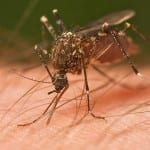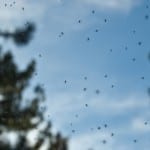
Summer’s 4 Most Vicious Outdoor Pests, and Tricks for Beating Them
Summer is one of the most fun times of the year. Long days, warm weather and vacation time make summer ideal for parties on the deck, enjoying your garden, and splashing around in the pool. But while you and your family are out enjoying your backyard, some potentially hazardous pests are out there waiting to put a stop to your summer fun.
Painful stings, toxic weeds such as poison ivy, and disease-carrying bugs such as ticks and mosquitoes really know how to spoil a good time.
Did you know they can even put your health in danger? Read on to find out how to avoid the danger, and what to do if you run across one of summertime’s worst pests.
1. Pests: Mosquitoes
Mosquitoes may not actually be evil, but they can sure seem that way when they’re swarming around you and diving in for a bite. And the wet spring followed by a hot, humid summer that much of the country has experienced this year has set up the perfect conditions for a real bumper crop of these bloodsucking menaces.
Besides leaving behind ugly bumps that never seem to stop itching and can become infected, mosquitoes also carry diseases that pose a danger to humans, such as encephalitis and West Nile Virus, and spread sicknesses that endanger the lives of our pets, such as heartworm.
The first line of defense against mosquitoes is to keep them from breeding. Most of the species of mosquitoes that live in the U.S. have very small flight ranges, so removing any standing water from your property can make a big difference in your backyard’s mosquito population.
Remember that even tiny amounts of standing water can provide a breeding ground for mosquitoes, and don’t forget to also look up when you’re checking for standing water.
High-up places where water can pool, such as bent spots in your rain gutters, are easy to overlook.
No matter how much we would love to be rid of mosquitoes, it’s just not possible to eliminate them completely. There is a huge variety of commercial products out there to help you keep mosquitoes from biting you and your family.
If you’re looking for a spray-on insect repellent, the CDC recommends products that contain either DEET, Picaridin, oil of lemon eucalyptus (PMD), or IR3535. There are also yard sprays available to kill mosquitoes in the grass; these products contain insecticide, so read the label carefully, especially if you have pets or small children.
There are also all-natural and DIY mosquito traps and repellants, for those who prefer the natural route. If you have a hammock, commercial zip-up mosquito nets designed to fit over hammocks are an effective, chemical-free way to keep mosquitoes away.
First Aid:
If you do receive a bite, treat the itching with OTC allergy creams or tablets. Try not to scratch the itch, and watch for signs of infection such as increased swelling and redness, pus, fever or swollen glands.
Resources:
- Signs and symptoms of West Nile virus
- Natural mosquito repellents
- Signs and symptoms of infected mosquito bites
- Heartworm in dogs
2. Pests: Ticks
Ticks are eight-legged relatives of spiders, but these little guys are responsible for many more health problems in the U.S. than their creepier cousins. They can spread many diseases to humans, some of which are serious.
Some of the more potentially dangerous tick-borne diseases in the U.S. include Lyme disease, which is transmitted to humans by the deer tick, also called the backlegged tick; tularemia, which is transmitted by the dog tick, the wood tick and the lonestar tick; and Rocky Mountain spotted fever, which is transmitted by the American dog tick, the brown dog tick, and the Rocky Mountain wood tick.
Ticks live in wooded areas, but you can also run across ticks in your own backyard or garden, or under the fur of the family pet. They attach themselves to a host animal (this means you) and stay in place while they suck the host’s blood.
Once the tick is puffed up and full of blood, it drops off of the host.
Ticks can’t fly, hop or jump, which makes them easier to avoid than mosquitoes. Ticks hold onto the edge of a leaf or branch waiting for an unsuspecting animal to brush against it, and then they latch on for a ride.
The best way to avoid tick bites is to keep your arms and legs covered and wear a hat when walking through the woods, or while you do any yard work that will involve a lot of contact with plants, such as pruning shrubs or trees.
Check yourself for any pests thoroughly after going into tick-infested areas.
Check your pets after they come in from wandering around outdoors, paying special attention to warm areas of the body such as under their ears or under their hips or “armpits.” A good flea and tick preventive product will help protect your pets and your human family members.
First Aid:
If you find a tick attached to your skin or your child’s skin, don’t panic. To remove the tick, use a pair of fine-tipped tweezers to grip the tick as close as possible to where it’s attached onto the skin.
Slowly and gently pull upwards on the tick with even, steady pressure. Pull the tick straight out; don’t twist or rotate it. Wash the bite and your hands thoroughly with soap and water, iodine, or rubbing alcohol.
If you develop a fever or rash within several weeks after the bite, see your doctor and tell her about the tick bite.
Resources:
3. Poison Ivy, Oak and Sumac
Part of gardening is pulling out weeds. But, certain weeds can make you wish you had never come in contact with them.
Poisonous plants such as poison ivy, oak and sumac produce oils that most humans are allergic to. When these oils get on your skin, they can cause a reaction.
This can mean anything from a small rash to a more serious condition that requires a doctor’s care. A poison ivy rash usually develops 12 to 48 hours after contact with the plant’s oil. These nasty rashes can last 2 to 3 weeks.
The best way to avoid weeks of miserable itching is to avoid these noxious plants. Familiarize yourself with what they look like and, when in doubt, treat a weed like it is poison ivy.
If you find one of these plants on your property, kill it with herbicide if possible. If you have to pull one of these plants, wear gardening gloves and completely cover your arms, legs, or any other skin that may come in contact with the plant.
Bag the weeds and dispose of them; never burn poison ivy, oak or sumac, because the oils can become airborne and cause a potentially serious respiratory reaction. After pulling up poison ivy, carefully remove your clothes without touching parts that may have plant oil on them, wash the clothes, and shower.
First Aid:
If you think you’ve come in contact with poison ivy, oak or sumac, immediately wash the area with poison plant wash, rubbing alcohol, or a degreasing soap such as dishwashing liquid. Rinse the area very thoroughly, dry the skin, and apply calamine lotion or anti-allergy cream.
You can also take oral antihistamines to treat a poison ivy reaction. If the rash is severe or involves your face or genitals, see a doctor.
Call 911 if you have severe swelling around your face or trouble breathing.
Resources:
- Photos of poisonous plants
- Photos of poison ivy rashes, and when to see your doctor
- Protection, symptoms and first aid
4. Pests: Bees, Wasps and Hornets
Hopefully, your garden is bursting with beautiful flowers this time of year. But those same blooms that attract hummingbirds and butterflies also attract bees and other stinging pests.
While bees are an important part of the ecosystem, a close encounter with a bee is no fun at all. Some stings can be a serious medical emergency for people with severe allergies.
To avoid being stung, always wear shoes when walking through grass. Don’t wear sweet-smelling perfume or other beauty products with sweet smells if you’re going to be outside.
Stay away from outdoor trashcans, which can attract some types of stinging insects. Always remember to wear gardening gloves while handling flowering plants.
If stinging pests fly around you, back away slowly; never try to swat it.
If a bee stings you, check to see if the stinger is still in your skin. If you see a stinger, remove it by gently wiping a piece of gauze across the area, or by gently scraping your fingernail across it; never use tweezers to remove a stinger.
Wash the site with soap and water, and apply ice to reduce swelling.
If you have a severe allergy to stings, consider wearing a medical alert bracelet. Should you happen to be stung, call 911 and use your emergency medical kit, if you have one. If you are with someone who loses consciousness or has trouble breathing after being stung, call 911.
Resources:
(Photos By Cliff, JJ Harrison)














geogator
Will this work on dirt dauber nests? When the nest if removed it leaves a very resistant film on bricks. WAF works great on my sidewalks and well house, but this will be harder because it seldom gets wet under the eaves of the house.
Wet And Forget
Hi Geogator,
Wet & Forget only targets organic growth like moss, mold, mildew and algae. You can try using Wet & Forget on your bricks to remove the film though you may not have any results. Thanks for commenting.